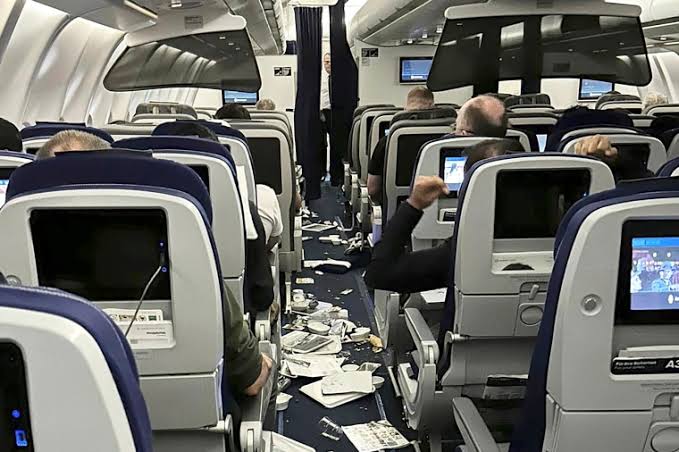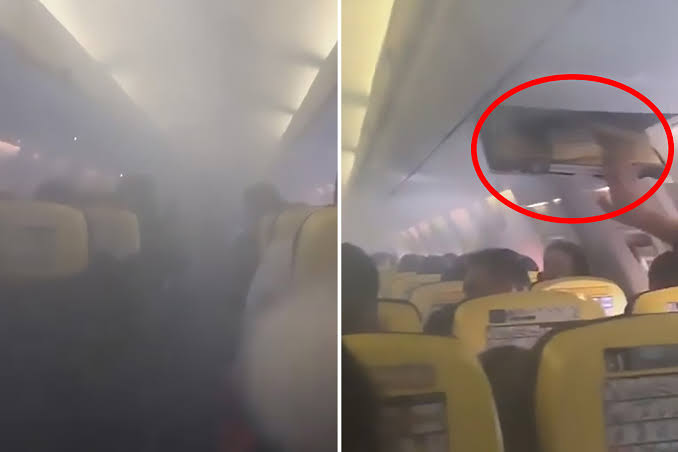Lufthansa Flight Hit by Severe Turbulence, Pregnant Woman Injured Mid-Air
Lufthansa Flight Hit by Severe Turbulence, Pregnant Woman Injured Mid-Air
A Lufthansa flight recently experienced severe turbulence, leaving passengers shaken and resulting in injuries, including a distressing incident involving a pregnant woman. The mid-air chaos unfolded unexpectedly, sparking concerns about airline safety and turbulence-related risks.
The Incident: Sudden Turbulence at High Altitude
The Lufthansa aircraft, en route to its destination, was cruising at high altitude when it suddenly encountered severe turbulence. Passengers were caught off guard as the plane began to shake violently, causing panic and fear among those on board. Many were jolted from their seats, and loose items flew around the cabin, adding to the chaos.
One of the most alarming incidents involved a pregnant woman who reportedly began to bleed due to the extreme turbulence. Witnesses described the moment as terrifying, with flight attendants rushing to assist her while other passengers struggled to maintain their composure.
Eyewitness Accounts: Chaos and Fear in the Cabin
Several passengers took to social media to share their harrowing experiences. One traveler described the turbulence as “the worst they had ever experienced,” emphasizing that the shaking felt like “an endless freefall.” Another passenger recounted how drinks, food trays, and even electronic devices were tossed into the air, creating a dangerous environment inside the cabin.
A flight attendant, who wished to remain anonymous, stated that the crew did their best to calm passengers and ensure their safety. “It was a terrifying few minutes,” they said. “We were securing everything, but the turbulence was so intense that even standing upright was difficult.”
The Pregnant Passenger’s Ordeal
The pregnant woman, whose identity has not been disclosed, reportedly suffered complications due to the turbulence. Witnesses stated that she was visibly distressed and in pain. Flight attendants quickly responded, offering medical assistance while the pilot communicated with ground control to assess possible emergency landing options.
Medical professionals later explained that turbulence-induced stress and sudden physical jostling could pose risks to pregnant women, including placental abruption or premature contractions. Fortunately, reports indicate that the woman received immediate care upon landing, though the severity of her condition remains unclear.
Understanding Turbulence: What Causes It?
Turbulence is a common occurrence in air travel, but severe turbulence can be dangerous. It is caused by various factors, including atmospheric pressure changes, jet streams, storms, and mountain waves. In this case, meteorologists suggest that the Lufthansa flight may have encountered unexpected clear-air turbulence (CAT), which is particularly hazardous because it is difficult to detect in advance.
CAT can strike suddenly, even in clear skies, and is often unpredictable. Unlike turbulence associated with thunderstorms, CAT is not visible on radar, making it challenging for pilots to anticipate.
Airline Response and Safety Measures
Lufthansa Airlines issued a statement expressing concern for the affected passengers and confirming that the flight crew followed all safety protocols. The airline assured travelers that turbulence-related incidents are taken seriously and that their aircraft are designed to withstand such conditions.
A Lufthansa spokesperson also emphasized the importance of keeping seat belts fastened at all times while seated, a crucial safety measure that can prevent injuries during unexpected turbulence.
Additionally, aviation experts highlight that while turbulence can be frightening, modern aircraft are built to endure extreme conditions. Pilots receive extensive training to handle such situations, and safety measures, including turbulence detection systems, continue to improve.
Passenger Safety: What Travelers Should Know
For passengers, turbulence remains an unsettling experience, but there are ways to minimize risks:
Always wear a seatbelt: Even when the seatbelt sign is off, keeping it loosely fastened can prevent injuries.
Follow crew instructions: Flight attendants are trained for emergencies and provide crucial guidance.
Avoid loose objects: Keeping personal belongings secured can prevent items from becoming dangerous projectiles.
Stay calm: Panic can escalate situations; deep breathing and remaining seated can help.
The Future of Turbulence Detection and Prevention
Aviation technology continues to advance, with ongoing research into better turbulence prediction tools. Airlines are investing in state-of-the-art weather tracking systems that can detect turbulence earlier, allowing pilots to adjust flight paths when necessary.
Furthermore, artificial intelligence (AI) and machine learning are being integrated into aviation safety, helping to analyze weather patterns and predict turbulence more accurately. These innovations could significantly reduce the risks associated with sudden turbulence.
The Lufthansa turbulence incident serves as a stark reminder of the unpredictability of air travel. While turbulence itself is a routine part of flying, extreme cases like this highlight the importance of safety precautions and preparedness.
For the pregnant woman and other affected passengers, the experience was undoubtedly traumatic, but the swift response from the flight crew and medical personnel helped mitigate further risks. As airlines continue improving safety protocols and turbulence detection, passengers can take comfort in knowing that air travel remains one of the safest modes of transportation.
Moving forward, incidents like this may push airlines and aviation authorities to explore even more advanced safety measures, ensuring that passengers can travel with greater confidence and security.






